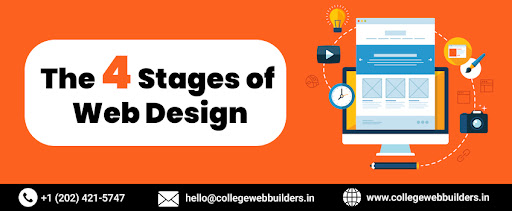
The 4 Stages of Web Design
A website design generally consists of several steps but further summing up to 4 main steps which can be termed as planning, designing, developing, and testing. A good website designing company in Delhi will give you a web design that meets technical, creative, and marketing skills in one place to make this piece of art in the IT world successful and huge.
Honestly, every web developer goes through these 4 main steps yet fails to give an outstanding website to the website owner due to lack of commitment in the work of graphic designing. As much as the technical part is important, the graphic design of the website is equally important because the way something looks becomes the first impression. Webtrills.in takes care of both technical and creative aspects.
Even Bill Gates said, "if you can't make it good, at least make it look good".
Well, read about the 4 stages of web design and also know how one can improve it to make a website successful.
Stages of Web Design
Web design typically involves several stages to create a successful website. Here are the four key stages of web design along with their important pointers:
1) Planning and Discovery:
- Define Goals and Objectives: Clearly identify the purpose and goals of the website. Determine what you want to achieve, such as increasing brand awareness, driving sales, or providing information.
- Research and Gather Information: Conduct market research, analyze competitor websites, and gather relevant content and resources for the website.
- Identify Target Audience: Define your target audience and understand their needs, preferences, and behaviors. This information will guide the design and content decisions.
- Create A Sitemap and Wireframes: Develop a sitemap that outlines the website's structure and navigation. Design wireframes to visualize the layout and placement of key elements on each page.
- Plan Content Strategy: Determine the type of content needed, such as text, images, videos, or interactive elements. Plan how the content will be organized and presented to engage and inform visitors.
2) Design and Development:
- Visual Design: Create a visually appealing and cohesive design that reflects your brand identity. Consider color schemes, typography, imagery, and overall aesthetics. Design a consistent user interface that is intuitive and easy to navigate.
- Responsive Design: Ensure the website is mobile-friendly and responsive across different devices and screen sizes. Optimize the user experience for mobile users, as mobile traffic continues to increase.
- Content Creation and Integration: Develop high-quality content that aligns with your brand and resonates with your target audience. Integrate the content into the design, ensuring it is presented effectively and supports the overall user experience.
- Development and Coding: Translate the design into a functional website using HTML, CSS, and other coding languages. Ensure the website is optimized for fast loading speed, cross-browser compatibility, and accessibility.
- Implement Interactive Elements: Incorporate interactive elements, such as contact forms, search functionality, social media integration, and multimedia elements, to enhance user engagement and functionality.
3) Testing and Optimization:
- Cross-browser and device testing: Test the website on different browsers and devices to ensure consistent functionality and visual appearance.
- Performance testing: Evaluate the website's performance, including page loading speed, responsiveness, and overall user experience. Optimize and make necessary adjustments to improve performance.
- Usability testing: Conduct user testing to gather feedback on the website's usability and identify areas for improvement. Ensure the website is intuitive, easy to navigate, and meets the needs of the target audience.
- SEO optimization: Implement search engine optimization (SEO) techniques to improve the website's visibility in search engine rankings. Optimize page titles, meta descriptions, headings, and content for relevant keywords.
- Analytics integration: Set up web analytics tools, such as Google Analytics, to track website performance, user behavior, and conversions. Use the insights to make data-driven decisions for further optimization.
4) Launch and Maintenance:
- Website Launch: Prepare the website for launch by finalizing content, checking for any errors or broken links, and ensuring all elements are functioning correctly.
- Deploy Website to Hosting Server: Transfer the website files to a web hosting server and configure domain settings for the website to go live.
- Post-launch Testing: Conduct thorough testing after the website launch to ensure everything is working as intended and address any issues promptly.
- Ongoing Maintenance: Regularly update and maintain the website by adding fresh content, monitoring performance, fixing any bugs or technical issues, and keeping the website secure.
- Continuous Improvement: Gather user feedback, monitor website analytics, and identify areas for improvement. Implement enhancements, updates, and new features to enhance the user experience and meet evolving business needs.
Benefits of An Attractive Web Design
An attractive web designing offers several benefits for businesses. Here are some key advantages:
1) Improved User Experience: An attractive web design enhances the user experience by creating a visually appealing and intuitive interface. It helps users navigate the website easily, find the information they need, and engage with the content effectively. This positive experience encourages users to stay longer on the site, explore more pages, and increases the likelihood of conversions.
2) Enhanced Brand Perception: A well-designed website reflects professionalism, credibility, and trustworthiness. It creates a positive first impression on visitors, instilling confidence in your brand. A visually appealing design that aligns with your brand identity helps establish a strong brand image and differentiates you from competitors.
3) Increased Engagement and Conversions: Aesthetically pleasing web design elements, such as high-quality images, compelling visuals, and well-structured content, capture users' attention and encourage them to engage with your website. This increased engagement leads to higher conversion rates, whether it's signing up for a newsletter, making a purchase, or filling out a contact form.
4) Better Search Engine Visibility: Search engines consider user experience as a ranking factor. A visually appealing and user-friendly website tends to have lower bounce rates, longer average session durations, and higher click-through rates, which positively impact search engine optimization (SEO). With proper optimization of design elements and relevant content, an attractive website is more likely to rank higher in search engine results, driving organic traffic.
5) Mobile-Friendliness: An attractive web design incorporates responsive design techniques to ensure compatibility across various devices and screen sizes. With the increasing use of mobile devices, having a mobile-friendly website is crucial. It improves user experience, reduces bounce rates, and helps you reach a wider audience.
6) Competitive Advantage: In today's digital landscape, having an attractive web design sets you apart from competitors. A visually appealing and well-designed website creates a memorable impression, making users more likely to choose your brand over others. It helps you stay ahead in the market, attract and retain customers, and establish a competitive edge.
7) Better Communication of Information: An attractive web design effectively organizes and presents information to users. It utilizes visual hierarchy, clear navigation, and attention-grabbing elements to guide users' attention and facilitate their understanding of the content. This streamlined communication ensures that users can easily find the information they seek, leading to a positive user experience.
Conclusion
In conclusion, understanding the four stages of web design is crucial for creating a successful website. The planning and discovery stage sets the foundation by defining goals, researching the target audience, and creating a sitemap. The design and development stage focuses on visual design, responsive development, and content integration. Testing and optimization ensure the website functions well, performs optimally, and meets user expectations. Finally, the launch and maintenance stage involves deploying the website, ongoing maintenance, and continuous improvement. By following these stages diligently, businesses can create a professional, user-friendly website that effectively communicates their brand message, engages visitors, and achieves their goals.
The stages of web designing need a lot of expertise and knowledge in the field. Also, a successful web design is not the job of a day or two. Web design is a consistent process and regular improvements help the website to stand out. To avail services of our website designing services company Ashburn USA, visit Collegewebbuilders.in .

.png)



